Global food security improves in 2023 with higher incomes, lower vegetable oil prices
- by Lila Cardell and Yacob Abrehe Zereyesus
- 9/21/2023

USDA’s International Food Security Assessment (IFSA) model estimates how food prices and incomes affect food demand and access in 83 low- and middle-income countries. Food security is then evaluated by estimating the share of a country’s population that is unable to access sufficient calories to sustain a healthy and active lifestyle. In IFSA countries in 2023, almost 229 million fewer people are estimated to be food insecure compared with 2022, a 16.8-percent decrease. That improvement stems from average annual income growth of 3.7 percent for countries included in the IFSA. In 2023, the average per capita Gross Domestic Product—a proxy for income—for the IFSA countries was $2,415, higher than the $2,253 average for 2020–22. In addition, the drop in the price of vegetable oils contributes to food security improvements in 2023. Vegetable oil is a common component of many foods and, according to the Food and Agricultural Organization of the United Nations, makes up about 10 percent of calories consumed in a day in low-income countries. The year-to-year reduction in food insecurity indicates recovery from factors that continue to affect the global economy, including the Coronavirus (COVID-19) pandemic, high inflation rates for food and farm production inputs, and the ongoing Russian military invasion of Ukraine. This chart appears in the USDA, Economic Research Service report International Food Security Assessment, 2023-33, published in August 2023.

